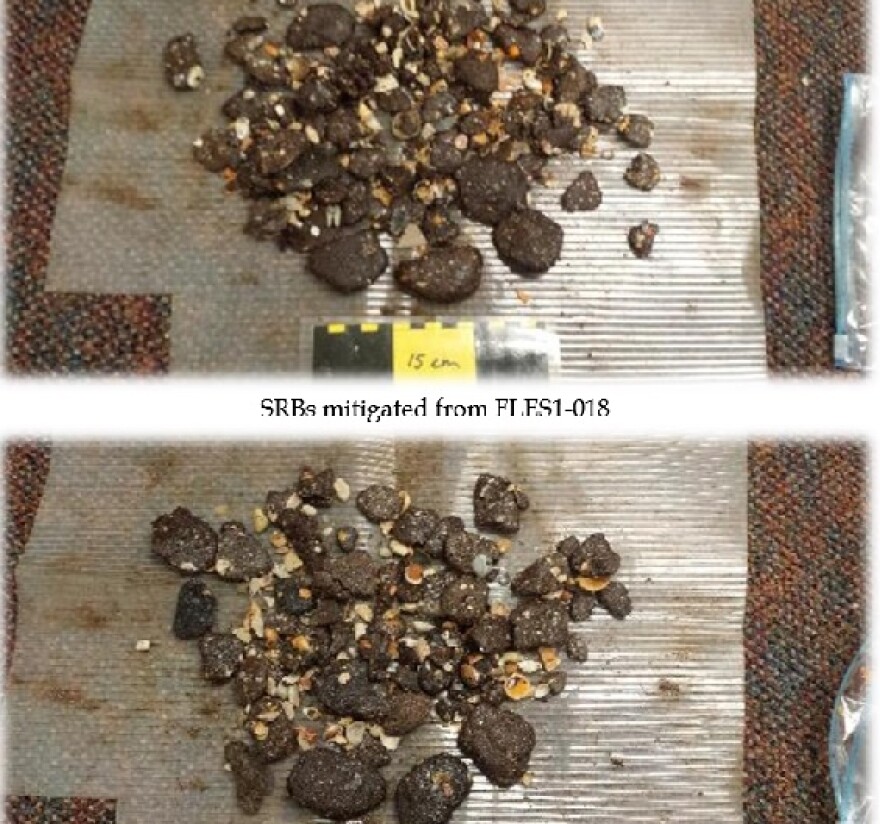Four years ago, an oil rig owned by BP exploded off the Louisiana coast—causing one of the largest oil spills in U.S. history. The oil flowed all the way to Florida's western panhandle, causing tourists to flee and businesses to dry up. Now tourism is back and the money is flowing again—but the oil remains.
Pensacola’s Fort Pickens Beach looks pristine. The sand is white, the dunes are gently rolling—the remains of the Old Fort jut out against a bright blue sky. Adults and children, with their brightly colored beach chairs, towels and umbrellas are soaking up the sun. But there’s something not-quite so nice lurking beneath their feet.
“Right now we’re looking at some oiled material, residual material from the BP Deepwater Horizon oil spill of 2010. This material washed ashore, became entrenched in sand, and was buried,” explains Joey Whibbs. He's a part of the Florida Department of Environmental Protection’s Beach Monitoring Team. Whibbs is pointing to what look like sand-covered pebbles on a picnic bench. He's been doing this since 2010 and has learned to spot BP oil from others.
“There are some other oils out there, but not in this nature. The only other oil i’ve observed [is] harder. They were suspected from a spill back in the 70’s. This material is rusty-brown, and when you find it, it’s stickier, tacky.”
Whibbs' team combs the beach nearly every day, and most of the time when they go out, they find oil. Recently, the group found a large, submerged patch of oil that according to DEP’s beach monitoring report, was 20 feet long, four feet wide, and three-to-six inches thick. Scientists are still trying to determine the long-term impact of the oil. And that, says Florida State University scientist Alan Marshall, will take a very long time.
“We find when we bury this stuff that it starts out as a layer. Then as sea water rand rain water go through, it percolates down into the ground water and eventually ends up there," Marhsall said. "It will be years and years this stuff will continue to show up.”
Marshall is part of a group that’s collecting samples of oil from the Gulf and trying to identify where they came from. He says every year, a million barrels of oil—much of it from natural causes like oil seeps, pour into the Gulf. The Deepwater Horizon Spill of 2010 dumped five million barrels of oil into the water, a million of which clean-up crews were able to scoop up.
“So, the first thing to decide when you see a tar ball or tar mat, did it come from nature, or did it come from the oil spill? What we have is very detailed molecular fingerprint, so we can tell which is which," Marshall says.
DEP officials say most of what they’re seeing at Fort Pickens beach is BP-Deepwater Horizon oil. Marshall says there are some misconceptions about the clumps on the beach. He says it’s not like what initially poured from the broken BP well. Dispersants--similar to what’s in dish soap--helped break up the oil, and Mother Nature did a lot of work too. Microbes in the ocean also had a feast.
“You’d think the oil that washes up on the beach should be simpler, have fewer kind of chemicals in it. But in fact, there are three-times as many chemicals, because the sun causes changes, the bacteria eat the oil, and they makes all kinds of new compounds—not all of them are good for you.”
Still, the oil at Fort Pickens hasn’t stopped longtime area resident Paul Bennett from visiting. Bennett says he comes to the beach at least once a week. And he remembers when, four years ago, the trip wasn’t so pleasant.
“Yeah, on occasion, not to the point it would keep me away or cause me concern. I know there’s a hotline to call if you see any and the clean-up guys can come out and do their thing," he says.
He's talking about DEP's oil reporting hotline, which, four years after BP's oil spill is still active. But Bennett says the oil that exists now on the beach, is nothing compared to what the area was like when the spill first occurred.
"There was a time there, for people who love the beach, it was really emotional. Anyway, I’m glad to see....and I really don’t think about it anymore.”
Bennett says he isn’t worried about the oil residue under the sand. The state continues monitoring the area for residual oil and is working with the U.S. Coast Guard and BP clean-up crews to remove what they find from the beaches.




